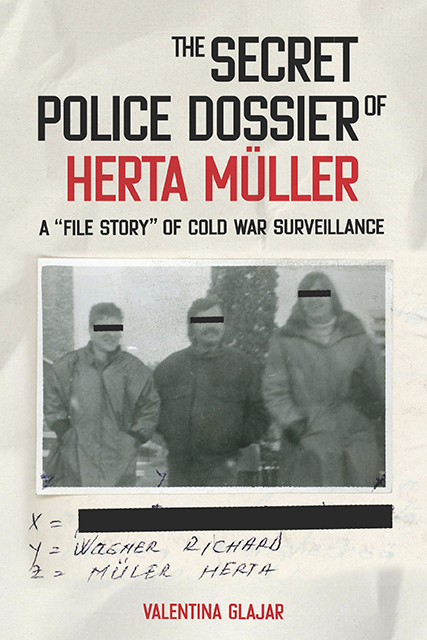Book contents
- Frontmatter
- Dedication
- Contents
- Preface
- Terms and Abbreviations
- Introduction
- 1 The Filed Story of Niederungen
- 2 Contact Stories: The Author and the Officer
- 3 Conspiratorial Stories: The Securitate Sources MAYER, SORIN, and EVA
- 4 Captured Stories: Remote Audio Surveillance
- 5 Migrating Stories
- Epilogue
- Bibliography
- Appendix I Müller’s Surveillance Timeline (1974–93)
- Appendix II Author’s Accreditation by CNSAS
- Index
Epilogue
Published online by Cambridge University Press: 10 June 2023
- Frontmatter
- Dedication
- Contents
- Preface
- Terms and Abbreviations
- Introduction
- 1 The Filed Story of Niederungen
- 2 Contact Stories: The Author and the Officer
- 3 Conspiratorial Stories: The Securitate Sources MAYER, SORIN, and EVA
- 4 Captured Stories: Remote Audio Surveillance
- 5 Migrating Stories
- Epilogue
- Bibliography
- Appendix I Müller’s Surveillance Timeline (1974–93)
- Appendix II Author’s Accreditation by CNSAS
- Index
Summary
On October 8, 2009, the Swedish Academy announced that Herta Müller, “who, with the concentration of poetry and the frankness of prose, depicts the landscape of the dispossessed,” had been awarded the Nobel Prize for Literature. Müller was only the third person born in Romania to become a Nobel laureate. The first was George Emil Palade (1912–2008), who received the prize for medicine in 1974; he was residing in the United States and was affiliated with Yale University at that time. The second, and most widely known, was the Holocaust survivor Elie Wiesel (1928–2016), born in Sighet, in northern Romania, who received the Nobel Peace Prize in 1986 as a US citizen. In 2014, a second Banat Swabian received the Nobel Prize, this time for chemistry: Stefan Hell, born in Arad, Romania, in 1962, and a German citizen since 1978. However, he, unlike Müller, had received more recognition in Romania before he received this honor; he had been a member of the Romanian Academy of Sciences since 2012. In fact, the only official mention of Müller in Timişoara as of June 2022 is a plaque that adorns a wall of the German-language Lycée Nikolaus Lenau that was able to produce two Nobel laureates (fig. 6.1).
The announcement of the Swedish Academy in 2009 sent journalists and television crews into a frenzy, as many invaded Müller's birthplace—the small isolated village of Nitzkydorf— Müller's inspiration for Niederungen. Yet the most provocative reaction came from the former Securitate officer Radu Tinu, who suggested that Müller owed the Securitate half the money she had received for the Nobel Prize. Banking on his alleged insider information, Tinu delivered the last episode in the saga about the Securitate and Müller. The Romanian journalist Ştefan Both secured an exclusive interview with the former deputy chief of the Timiş Securitate and published a series of articles in the Romanian national newspaper Adevărul (The Truth) in November 2009. Tinu did not disappoint his audience and referenced aspects about the Nobel laureate's surveillance barely available by 2009. Müller's file had been recently unearthed and had been of little interest to the general public until the news about Müller's Nobel Prize created an uproar in Romania. Blunt and unapologetic, Tinu accused Müller of being psychotic and of inventing stories about her surveillance.
- Type
- Chapter
- Information
- The Secret Police Dossier of Herta MüllerA 'File Story' of Cold War Surveillance, pp. 243 - 248Publisher: Boydell & BrewerPrint publication year: 2023

